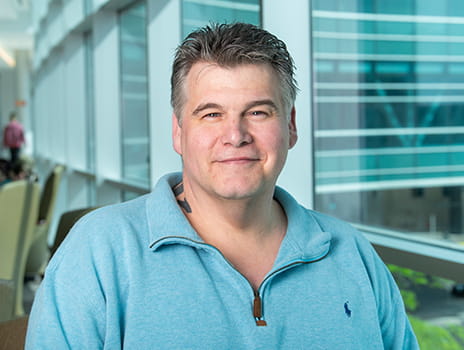August 01, 2019
While George Huntington was on vacation in New Orleans, he smoked a cigar, something he rarely did. But it was a special occasion. His friend was getting married, and George was celebrating at his bachelor party.
Soon after the cigar, George became short of breath.
"Almost like breathing through a sponge," he says.
George thought the cigar had triggered his asthma, a condition he was diagnosed with as a child. He left the party early and returned to his hotel room to rest.
Symptoms of HOCM worsen over the years
For the past few years, George, then age 40, had had more difficulty breathing.
"I lived on albuterol inhalers, steroids and Primatene® MIST," he says.
His doctor at the time blamed George's difficulty breathing on his asthma and weight, but George wasn't convinced.
In fact, George led an active life, playing hockey up to 3 times a week in a men's recreational league in Kansas City, Missouri, where he lives. Out on the rink, George's asthma symptoms improved, a result of the cold, dry air.
Professionally, George was a painter and photographer, and shortness of breath was affecting his livelihood.
"It limited the shows and events I could do. And it took a toll on my attitude," he says.
A trip to the hospital
Back at the hotel in New Orleans, George soaked in a cold bath, which always made him feel better, and went to bed.
At 3 a.m., he woke up coughing and could taste blood in his mouth. A member of the bachelor party, a firefighter, called 911. When emergency medical technicians arrived, they could not get a good blood pressure reading and discovered George's veins had collapsed. He was taken to a local hospital.
"I was quarantined for a week," George says. "They thought I had hepatitis."
When the hepatitis test came back negative, the staff had found nothing else wrong, so they conducted an electrocardiogram. Suspecting George's mitral valve might be malfunctioning, they sent him home to Kansas City to seek further treatment.
Thickening of the heart muscle
Once in Kansas City, George's health insurance provider referred him to The University of Kansas Health System. That's where he met cardiologist Mark Wiley, MD.
"Dr. Wiley didn't think I had a mitral valve problem. He thought I had hypertrophic cardiomyopathy," George says.
"Most community hospitals don't have the ability to treat HCM using a multispecialty approach, and may see these patients less frequently," Dr. Wiley says. "As an academic medical center, we have the expertise from treating a large number of patients and a multispecialty program." The care team includes heart rhythm specialists, interventional cardiologists, imaging specialists in general cardiology and cardiothoracic surgeons.
HCM is a disorganization of the heart muscle fibers that causes the heart muscle (myocardium) to abnormally thicken (hypertrophied). The thickened heart muscle can make it harder for the heart to pump blood.
"One way HCM presents itself is shortness of breath, so it is often misdiagnosed," Dr. Wiley says.
Surprised by the diagnosis, George sought a second opinion.
A second EKG indicated a heart murmur and confirmed a type of HCM called hypertrophic obstructive cardiomyopathy or HOCM. George's thickening was around the base of his heart, which obstructed the flow of blood leaving the heart.
"Part of the mitral valve was getting sucked into the outflow tract. When the heart contracted, the mitral valve opened, causing the valve to leak," Dr. Wiley says.
Most community hospitals don't have the ability to treat HCM using a multispecialty approach, and may see these patients less frequently. As an academic medical center, we have the expertise from treating a large number of patients and a multispecialty program. – Mark Wiley, MD
Cardiology
HCM: A genetic disease
HCM runs in families as a dominate genetic trait. About 1 in 500 people carries the gene.
"Our program is dedicated to and understands HCM patients," Dr. Wiley says. "We understand their hereditary patterns and genetic concerns. If one parent has the abnormal HCM gene, each child has a 50% chance of inheriting the disease."
But no one in George's family had been diagnosed with HCM, which is why Dr. Wiley's diagnosis came as a surprise.
"Some people carry the gene and live their entire lives without any symptoms," Dr. Wiley says.
Getting the right HOCM treatment
Dr. Wiley's first course of action was to perform an alcohol ablation on George's heart. The alcohol, guided by echo imaging to the thickened area, thins the muscle by killing cells and stopping the leak.
George then receive an implanted cardioverter defibrillator (ICD) – a pacemaker and defibrillator in one. The defibrillator provides an electrical shock to restore George's heartbeat when it beats out of rhythm. He also takes medication to help prevent his heart from skipping beats.
After the procedures, George's asthma symptoms nearly disappeared.
Living with HOCM
Since then, George has had another ablation and a cardiac catherization, which allows Dr. Wiley to see how much blood is being supplied to his heart.
"Now that we have dealt with the obstruction and he has an ICD," Dr. Wiley says.
Today, George is restricted from competitive or high-intensity sports because they put him at-risk for heart rhythm abnormalities that can be life-threatening. He is free to enjoy other activities.
At age 51, George describes himself as being in "pretty good shape," having just vacationed with his wife, Joni, in Montreal, Canada, for the Grand Prix.
"I wouldn't be where I am without Dr. Wiley and the heart team at The University of Kansas Health System," he says.
If you think you have HCM, call 913-588-1227 to make an appointment with a cardiologist.





